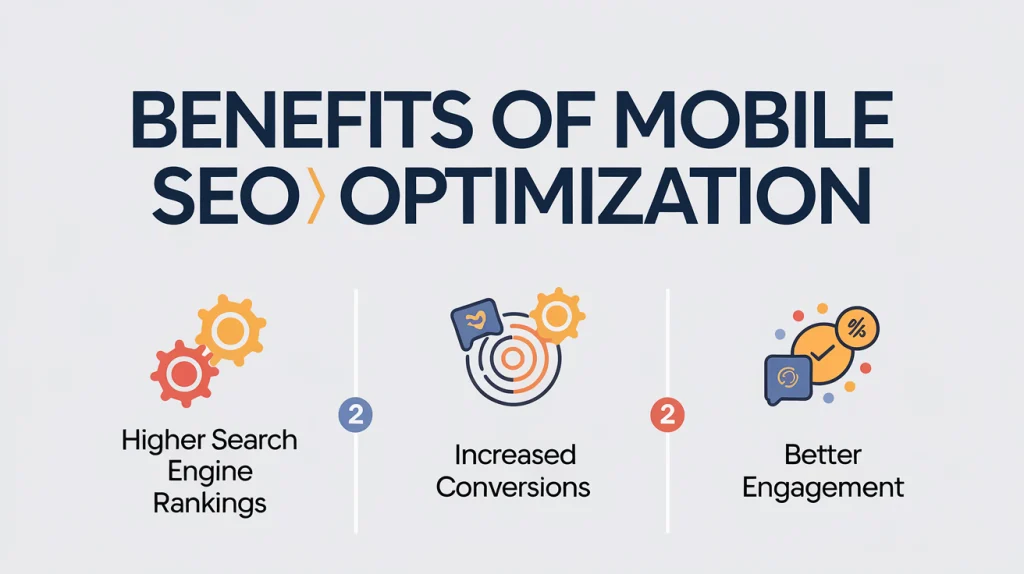As mobile usage continues to skyrocket, mobile SEO optimization is more crucial than ever. With Google prioritizing mobile-first indexing, it primarily considers the mobile version of your website for ranking. Ensuring a seamless, fast experience across devices is essential to improving SEO and attracting visitors.

Why Mobile SEO Optimization is Important
Mobile Traffic is Growing:
With over half of global web traffic coming from mobile devices, failing to optimize for mobile means missing out on a huge portion of potential users. People expect websites to load quickly and function smoothly on mobile, and providing that experience can make or break their engagement with your brand.
Google’s Mobile-First Indexing:
Since Google considers the mobile version of your site first, a non-optimized mobile experience can hurt your SEO rankings. This mobile-first indexing approach is now the standard, so if your website isn’t mobile-friendly, it could rank lower on search engine results pages (SERPs), reducing your visibility and traffic.
Enhanced User Experience (UX):
A mobile-friendly site offers smooth navigation and clear layouts, leading to higher engagement, longer visits, and lower bounce rates—all factors that impact SEO rankings. Sites that load quickly, display information clearly, and respond well to touch-based navigation create a better experience for users, which helps improve SEO over time.
A mobile-friendly website is key to improving both SEO and user experience. Google now considers user experience as part of its ranking factors, meaning a fast, easy-to-navigate mobile site can boost your SEO performance. For more on how a great user experience can lead to SEO success and higher rankings, explore this post on the Role of User Experience in SEO Success. By focusing on mobile SEO optimization and user-friendly design, you’ll help your site rank better and keep visitors engaged longer.
Key Strategies for Mobile SEO Optimization
1. Mobile-First and Responsive Design
Ensure your website automatically adjusts to different screen sizes. A responsive design is crucial for providing a consistent user experience across devices.
2. Improve Page Load Speed
Mobile users expect fast load times. Use tools like Google PageSpeed Insights to find speed improvements. Compress images, optimize CSS/JavaScript, and consider lazy loading for a faster mobile experience.
3. Enhance Mobile Navigation
Simplify navigation with clear menus and touch-friendly buttons. Minimize pop-ups, which can frustrate users and increase bounce rates.
4. Prioritize Mobile Content
Content for mobile needs to be concise and easy to scan. Use headings, bullet points, and short paragraphs to improve readability on smaller screens. Ensure images and videos are optimized for mobile.
5. Test Your Mobile Site Regularly
Use Google’s Mobile-Friendly Test to check your site’s mobile performance. Regularly monitor user behavior through analytics and make adjustments to meet evolving needs.
Advanced Techniques for Mobile SEO Optimization
In addition to the basics, there are a few advanced techniques that can further boost your mobile SEO:
- Accelerated Mobile Pages (AMP): AMP is a framework by Google that allows you to create lightweight pages specifically for mobile. These pages load almost instantly, making them ideal for users on mobile networks. Google favors AMP pages in search results, so implementing AMP can boost both user experience and SEO.
- Structured Data and Mobile Optimization: Structured data (such as schema markup) helps search engines better understand your content and can enhance your mobile listings with rich snippets. Rich snippets, like reviews or product details, can make your site stand out in mobile search results and potentially improve click-through rates.
- Implement Progressive Web Apps (PWA): PWAs are a hybrid of websites and apps, offering offline access and fast loading times, even in areas with poor connectivity. PWAs offer app-like experiences without the need for users to download anything, which can enhance mobile user engagement and potentially improve SEO.
Benefits of Mobile SEO Optimization
- Higher Search Engine Rankings: Mobile optimization directly impacts SEO rankings, helping you stand out in SERPs.
- Increased Conversions: Users are more likely to convert if they can easily navigate your mobile site.
- Better Engagement: A fast, intuitive mobile site encourages users to spend more time engaging with your content.

Tools for Mobile SEO Optimization
- Google PageSpeed Insights: A tool to assess and improve loading speed on mobile and desktop.
- Google Mobile-Friendly Test: A free tool for assessing mobile compatibility and finding ways to enhance user experience.
- AMP (Accelerated Mobile Pages): Google’s AMP framework helps create ultra-fast mobile pages, which can boost mobile SEO.
Conclusion
Optimizing for mobile-first indexing and mobile SEO best practices is essential in today’s mobile-dominant world. With more users browsing on mobile, creating a fast, mobile-friendly experience is key to retaining visitors and ranking higher. By following these strategies, you’ll enhance your website’s mobile performance and position it for long-term SEO success.

